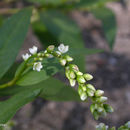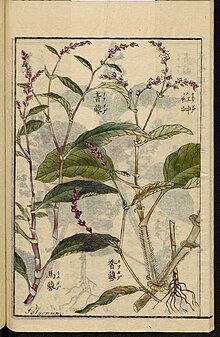en
names in breadcrumbs


Persicaria is a genus of herbaceous flowering plants in the knotweed family, Polygonaceae. Plants of the genus are known commonly as knotweeds[2]: 436 or smartweeds.[3] It has a cosmopolitan distribution, with species occurring nearly worldwide.[3][4] The genus was segregated from Polygonum.[5]
The genus includes annual and perennial herbs with taproots or fibrous root systems, or with rhizomes or stolons. The stems are often erect but may be prostrate along the ground, and some species are prickly.[3] The stems are self-supporting or twining and climbing.[6] The leaves are alternately arranged, deciduous, and variously shaped. The brownish or reddish ochrea may be leathery to papery. The inflorescence may be a panicle or a spikelike or headlike arrangement of fascicles of flowers. The flower is white, greenish, reddish, pink or purple, with the tepals partially fused together along the bases. The fruit is an achene which can take a number of shapes, including a disc or a sphere.[3]
Within the family Polygonaceae, Persicaria is placed in the subfamily Polygonoideae, where the tribe Persicarieae consists of two sister genera, Bistorta and Koenigia, together with Persicaria.[7]
PersicarieaePersicaria
Bistorta
Koenigia
As of February 2019, Plants of the World Online accepted the following 131 species:[8][Note 1]
 Illustration from the Japanaese agricultural encyclopedia Seikei Zusetsu (1804)
Illustration from the Japanaese agricultural encyclopedia Seikei Zusetsu (1804) Persicaria is a genus of herbaceous flowering plants in the knotweed family, Polygonaceae. Plants of the genus are known commonly as knotweeds: 436 or smartweeds. It has a cosmopolitan distribution, with species occurring nearly worldwide. The genus was segregated from Polygonum.
 Persicaria amphibia
Persicaria amphibia  Persicaria glabra
Persicaria glabra  Persicaria longiseta
Persicaria longiseta  Persicaria minor
Persicaria minor  Persicaria orientalis
Persicaria orientalis